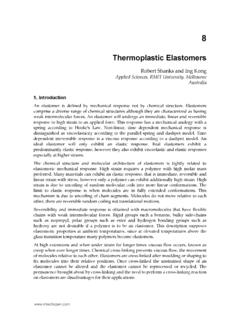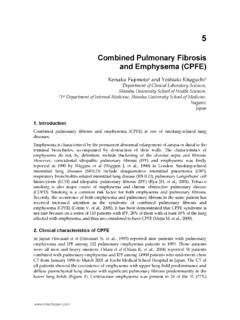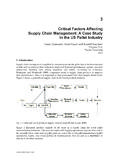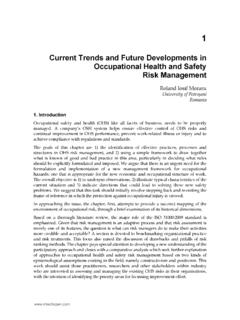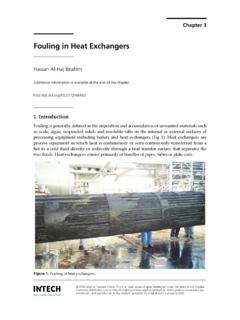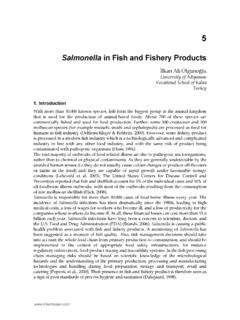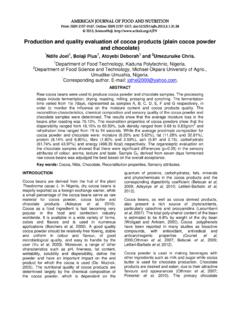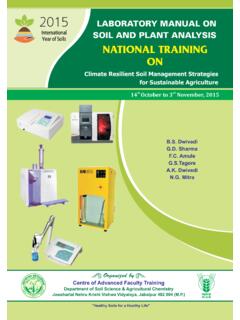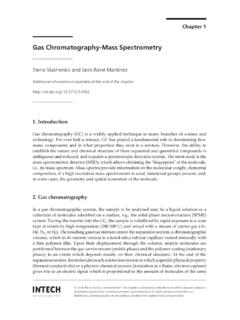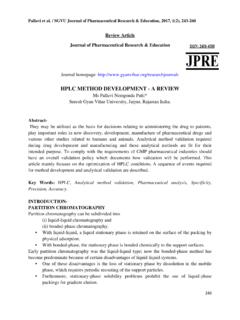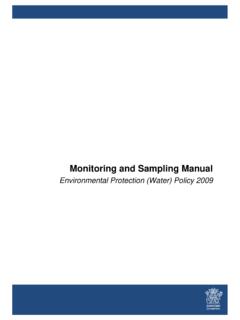Transcription of Effect of Heat on Egg White Proteins - IntechOpen
1 International Conference on Applied Life Sciences (ICALS2012) 407. Turkey, September 10-12, 2012 ISALS. Effect of Heat on Egg White Proteins Zoubida Akkouche*, Lyes Aissat, Khodir Madani Faculty of Nature and Life Sciences, 3BS Laboratory A. Mira University, Bejaia, Algeria *Corresponding author, Tel.: +213 0790285388; fax: +213 30 40 62 71. Email: Abstract Thermal treatments applied to the egg White cause undesirable modifications of their physico - chemical and functional properties. The goal of this study was to acquire some knowledge on the Effect of heat on some physico - chemical properties of the albumen while applying different scales (temperature / time). The results show: a sigmo dale evolution with negative slope of the transmittance, an irreversible loss of solubility.
2 Native-Page of protein's albumen shows the ap- parition of several bands what denotes diversity of Proteins in egg White . The comparison of these profiles dealt to different temperatures /20 min with those unprocessed, shows apparition of new bands and different relative mobility due to the formation of aggregates. Coagulation and/or precipitation of these Proteins have been observed around 74 C/20 min. Keywords: Proteins , egg White , heat denaturation. 1. Introduction Man has used bird eggs as food since prehistoric times [1, 2]. This reserve of Proteins , lipids, vi- tamins and minerals is remarkable for varieties of nutrients it contains and their high nutritional value, due to a perfect balance of its constituents. Egg is always recognized as a food of high nu- tritional quality for humans [3, 4, 5, 6, 7].
3 Beyond their nutritional value, their primary function, namely the formation of a new individual, suggests that they contain many compounds essential to life, and therefore they constitute a major potential source of biological active molecules which interest the pharmaceutical, cosmetic and food [8, 9, 10].The food industry currently uses largely hen egg (especially egg White ) as an ingredient, despite competition from increasingly strong dairy products. The origin of this interest is many functional properties of this latter (foaming and gelling properties in particular) [11].Egg White protein's are rich in essential amino acids, and possess excellent nutritional value, thus they have long been considered as reference pro- teins [12, 13, 14]. Nevertheless, the White gotten from breaking eggs is sensitive to contamina- tions of the environment [15, 16].
4 To fight against these infections and protect the consumer, the heat treatment of food egg is often required to ensure microbial safety or to obtain desirable organoleptic attributes [17].The egg White is a hydrated medium, viscous, rich on protein, heat treatment would cause a distortion of its components, the non-enzymatic browning and coagu- lation of Proteins [18, 19]. Polypeptide chains are unfolded and can form a gel or aggregates by the association of these molecules [20]. This aggregation leads to significant changes in the physico - chemical and functional properties of egg Proteins [20, 21, 22, 23, 24].It is therefore very 2012 Akkouche et al.; licensee InTech. This is an open access chapter distributed under the terms of the Creative Commons Attribution License ( ), which permits unrestricted use, distribution, and reproduction in any medium, provided the original work is properly cited.
5 408. important that manufacturers in the industry provide an egg product that combines functional- ity and safety [25].To limit the damaging effects of heat treatment, some researches propose the addition of additives to increase protein stability to heat. Plant's extracts rich in polyphenols as caffeic acid, helps to increase the thermal stability of milk Proteins to the heat [26]. chemical structure of these substances makes them a highly developed ability to bind to all sorts of mol- ecules, primarily Proteins [27]. The purpose of this study was to gain knowledge on the Effect of heat on some properties of egg White Proteins . This new knowledge will be useful in improving methods of pasteurization and sterilization to reduce the negative impact of heat on technological properties of egg White .
6 2. Materials and methods Preparation of egg White After washing and cleaning of eggs bought in trade, they are carefully broken and the White and yolk separated, taking the precaution of removing chalazae. The pH of the albumen is mea- sured immediately using a pH meter (Hanna Instruments, Microprocessor pH211 pH Meter); it is equal to The volume of egg White is measured using a test-tube and then adjusted with the buffer solution Tris-HCl (20 mM pH ) to obtain a dilution solution of 1:200. A gentle stirring for 10 minutes is done on the samples, followed by filtration with a strip agase. Identical volumes were transferred into tubes. After heat treatment in a water bath thermostated (Memertt) under continuous agitation at temperatures of 56 C to 89 C with a step of 3 C for 3 min ,10 min and 20 min, the tubes were immediately immersed in an ice bath for 1 minute to stop the denaturation process [16,24].
7 Measure of transmittance It consists in measuring the transmittance of the egg White processed relative to that of untreated;. the latter is used to bring back the turbidity at 0 (which corresponds to a transmittance of 100%). This measure is performed at a wavelength of 650 nm [24], immediately after heat treatment and after 24 hours of storage at 4 C. Determination of protein solubility The treated samples were centrifuged at 20000 g for 20 min at 4 C [24]. The Proteins of the su- pernatant were measured by the Bradford method [28]. Solubility S (%) of Proteins is expressed relative to an untreated White using the following formula: Concentration of Proteins in supernatant treated S% =. Concentration of Proteins in supernatant untreated The measurements are carried out immediately after the heat and after 24 hours of storage at 4 C.
8 International Conference on Applied Life Sciences (ICALS2012) 409. Turkey, September 10-12, 2012 ISALS. Polyacrylamide gel electrophoresis under native conditions (NATIVE-PAGE). The equipment used is the mini-plate vertical electrophoresis on polyacrylamide gel described by Laemmli (1970) [29]. The protein electrophoresis under non denaturing conditions is done to separate Proteins of egg White as a result of an electric field on a separating gel with of acrylamide and a staking gel with 5% of acrylamide. The rate of separation depends on the mass and charge of each protein [30]. 3. Results and Discussion Turbidity Turbidity is inversely proportional to the transmittance. Figures 1 show a negative slope sigmoi- dal evolution of protein denaturation of albumen to increasing temperatures ranging from 56 C.
9 To 89 C during 3 min, 10 min and 20 min respectively, it has been measured immediately after heat treatment at 650 nm. Fig 1. Effect of heat time on egg White turbidity, measures done immediately after heat. This sigmoid with negative slope includes four distinct parts: Stationary Phase 1: The transmittance is steady according to the temperature. This phase could be considered as the phase of denaturation of Proteins . Downward Phase: Corresponds to a negative evolution of the transmittance according to temperature. It is about the transition phase between the stage of denaturation and the stage of aggregation. The slope of this part informs us on the speed of transition between the stage of denaturation and the one of aggregation. Stationary Phase 2: This phase could correspond to the phase of aggregation of Proteins .
10 Ascending Phase: All curves include a positive phase from 86 C. This reduction of trou- ble could be associated to the sedimentation of the aggregates formed or to the formation of the S-Ovalbumine of which the ray of Stock is weaker than the one of native protein of a factor of 2, what drives to the formation of small size aggregates. 410. Statistical analysis reveals that the percentage of transmittance measured immediately and after 24 hours storage at 4 C of heat change over time was significant (P < ) and that the disorder is less important at 3 min than 10 min and 20 min respectively. So while extending heat, the trouble appears rapidly (lower temperature) ;for transmittance measured immediately after treatment, the trouble appears from 59 C at 20 min.
